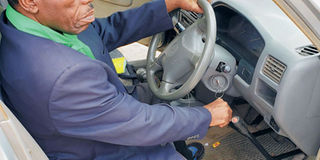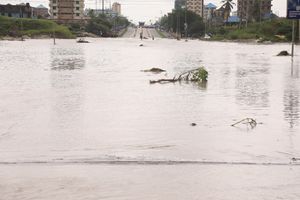On a journey to make walking safer for disabled pedestrians

Six decades ago, Jutoram Kabatele, 64, from Dar es Salaam, lost the use of both legs when he became very ill and was diagnosed with polio.
After remaining confined to the wheelchair for nearly all his life and never been able to sense what walking feels like, Kabatele bought a car just few years ago. “I was ridiculed for dreaming too big,” recalls Kabatele, who then went on to develop a hand-control system so that he could drive.
He came up with a simple mechanical device with two hand-operated levers for brake and accelerator, fitted to the gear rod. The iron levers are connected and screwed under the pedals.
“I have used bicycle handlebar rubbers for grip and slightly bent the rod at 45-degree angle to screw it to the pedals,” he explains.
Suited up with black shades, Kabatele looked no less than a James Bond 007.
As he drove his self-modified car to Buguruni, Dar es Salaam, with one hand on the steering wheel and the other maneuvering through the hand pedals, Kabatele had mastered the art of driving with ‘just’ hands.
A green bumper sticker with a stick figure illustrating a person on a wheelchair driving just below his car insurance on the left-hand side of the windscreen is something Kabatele has designed to signify the fact that the car is being driven by a differently-abled person (a person with a disability).
The grey exterior of his car has five road sign stickers, all distant from another, illustrating five kinds of disability. This is something Kabatele is proud of, after all he is the first Tanzanian to design and create these road signs catering to all the five kinds of disability, which are: vision impairment or blind, albinism, hearing impairment or deaf, physical disability and mental health/intellectual disability.
“Almost 18 years ago when I started researching about the challenges, fear and gaps of road safety for differently-abled people in Tanzania, I came to realise that there were no road signs catering to specific kinds of disability, and after three years of research, I designed five specific road signs to not only aid the handicapped cross the road safely but also help the Good Samaritans who always reach out to help people with disabilities cross,” says Kabatele.
First stop
Kabatele parked right in front of the road sign in Buguruni Malapa that had two slates, one illustrating a person on a wheelchair and below it was a sign that he had designed that was illustrated by an ear and had a red strip cutting through it diagonally. “The first one that you see is a common one that you might see almost across all the highways in the city, the second one signifies hearing impairment telling, drivers to be vigilant and to drive really slowly in this area,” Kabatele explains.
Adding, “This road sign was particularly and purposely kept in this area because few metres down the road, there is a school called ‘Buguruni School for the Deaf’ that has around 236 students with hearing disability studying there.”
“Fasten your seat belt,” he says.
Down the memory lane
As he was driving towards the school, Kabatele recalled his own painful time when he was schooling. “I grew up without a father and life was very difficult for my mother to provide for my needs,” Kabatele tells.
At 2 when Kabatele lost the function of both his legs, he never knew what walking feels like – till date. In 1966, he was enrolled in primary school in Kisarawe but it was never a normal school day for him. “I never had a wheelchair or any sort of support to help me mobilise from home to school back then – so I had to drag myself for almost 10kms to reach school and get back home,” he recalls. The environment wasn’t suitable for Kabatele to focus on his studies and continue. So he dropped school after standard four.
In 1970, with the help of Good Samaritans, he repeated standard four, but again circumstances weren’t favourable – so he couldn’t finish schooling.
Despite the hurdles, Kabatele did not feel pity for himself. He pulled himself up and self-learnt a guitar and in 1978 he formed a band called City Sound in Ilala where he was the lead singer and a guitarist. “Through music I would escape all my pain and it did help me earn my daily bread,” says Kabatele.
At the school
While he sang one of his favourite songs from the 70’s through the gates of Buguruni School of the Deaf, Kabatele lived his past for few seconds. He was greeted by Omary Nassoro, one of the teachers of the school who has been teaching students with hearing impairment for the past 17 years.
When Life&Style spoke to Mr Nassoro about the importance of special road signs, he said, “Being deaf is a hidden disability, it’s the kind of disability that people wouldn’t be able to tell. We have had cases of students being hit by vehicles on the road, simply because they can’t hear the cautionary honks by the drivers.”
Adding, “And this is the reason that signs - zebra crosses and bumps, are an important aspect on the road. You see, installing a road sign is one thing, but drivers being aware and taking note of the sign is another thing altogether. If the drivers are aware of these signs, which gradually they are becoming aware of the fact that the Bugurini Malapa road is often used by students who have hearing disability, then they know they need to slow down to let the student cross,” he says.
Mr Nassoro said that they have trained students who have formed a road safety team, despite the fact that road safety subject is not part of the curriculum, he says it is important and duty of all the teachers to teach students about it.
He demonstrates how every morning the students stay on each side of the road with ‘stop’ and ‘go’ boards to help their fellow students cross the road in the morning and late afternoon.
“I urge the government to take note of these signs to be put throughout the city to help the handicapped feel safe on the roads,” suggests Mr Nassoro.
Towards Temeke
As he drove from the school towards Wireless, Temeke, another area where the road sign is put up, Kabatele continues to tell his story. He gave up his band in 1982 and instead went to National Institute of Transport (NIT) to learn driving, understand the road signs and rules.
Stuck in the traffic, Kabatele recalled how for almost 10 years he felt stuck in his life – doing petty businesses here and there to earn a living. Few years before he started his research in 2002 on road safety for persons with disability, he had a calling. “I was just touched by seeing how people with all sorts of disability feared to be on the road and how the environment was not suitable for us,” he says.
For three years, Kabatele travelled to Tanga, Pwani, Arusha, Mwanza and around Dar es Salaam to conduct his research where he found out that handicapped people feared crossing the roads, there were no signs to caution drivers about people with disability, travel buses were not friendly for people with disabilities and there was no driving school or teachers dedicated to teach amputees or disabled people on how to drive.
“I was surprised to see that there are special road signs drawn for cattle and other livestock as well as wild animals, but nobody had ever thought of coming up with road signs for people who are physically or mentally impaired,” said Kabatele, adding that he thus decided to take up the initiative himself.
In 2010, he was recognised by the parliament of Tanzania and in 2013, the former President of Tanzania, Jakaye Kikwete launched and ordered that these 5 special signs designed by Kabatele be put up throughout the country.
Final destination
For 40 minutes, as the traffic was still at a standstill, Kabatele had to break the journey to attend to other commitments. In Dar es Salaam, the designer’s special road signs have been put in four areas only, that is; Buguruni Malapa, Wireless Temeke, University of Dar es Salaam, and Rutihinda. “These areas have been specially chosen because there are special schools around these areas,” Kabatele explains.
As Kabatele heads towards town, he spots a green bajaj (three-wheeler) and exchanges greetings with the driver. “He is one of my students,” says Kabatele. Kabatele has taught more than 200 bajaj drivers with disability in the country in an effort to make them able and independent.
“The reasons I want to teach people with disability to learn how to drive, learn what road safety means and rules is that first I want them to be independent, and secondly I don’t want anyone to fill pity – if we break the road rule, then we must pay for it – we don’t need sympathy – because if our minds get used to it – then that would mean breaking the road law would be ok and this will not only jeopardise someone else’s life but also their own,” Kabatele tells.
As he finally ends the journey, Kabatele tells, “Don’t feel sorry for me, I am not disabled. I am just a little differently-abled than you.” And he continues his journey to chase his dream at 64 - one of changing the lives of about 3000 differently-abled people in Tanzania.
Kabatele is currently the chairman of National Committee for Persons With Disabilities on Road Safety.




